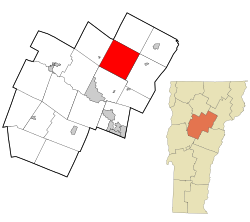North Calais, Vermont
| Calais, Vermont | |
|---|---|
| Town | |

Calais Town Hall
|
|
 Location in Washington County and the state of Vermont |
|
| Coordinates: 44°21′48″N 72°27′59″W / 44.36333°N 72.46639°WCoordinates: 44°21′48″N 72°27′59″W / 44.36333°N 72.46639°W | |
| Country | United States |
| State | Vermont |
| County | Washington |
| Area | |
| • Total | 38.6 sq mi (99.9 km2) |
| • Land | 38.0 sq mi (98.5 km2) |
| • Water | 0.6 sq mi (1.5 km2) |
| Elevation | 1,109 ft (338 m) |
| Population (2010) | |
| • Total | 1,607 |
| • Density | 42/sq mi (16/km2) |
| Time zone | Eastern (EST) (UTC-5) |
| • Summer (DST) | EDT (UTC-4) |
| ZIP code | 05648; (East Calais, 05650) |
| Area code(s) | 802 |
| FIPS code | 50-11350 |
| GNIS feature ID | 1462062 |
| Website | www |
Calais /ˈkælɪs/ is a town in Washington County, Vermont, United States. The population was 1,607 at the 2010 census. Calais is homophonous with callous. Calais contains the unincorporated communities of Adamant, East Calais, North Calais, Kent's Corner, Maple Corner and Pekin.
Colonel Jacob Davis named Calais after the French port city of the same name, during a time of general enthusiasm for things French as a result of France's aid during the American Revolution.
The Wheelocks and Parkers were the first families to settle the town, in the latter part of the 18th century. In the early and mid 19th century, the Vermont wool industry spawned sheep pastures in the town. Photographs of the time show a heavily de-forested Calais. Like many small Vermont towns, Calais was devastated by the Civil War. Volunteers from Calais flocked to the Union cause, most serving in the Army's volunteer regiments. In the post-Civil War era, agriculture turned from sheep to dairy, and new families came to fill farms that were sold by the families and widows of Civil War veterans.
Calais once had a village called Sodom. This name was allegedly given because the village had no church, though it did have a few active quarries. In 1905, the residents petitioned the state legislature to change the name to Adamant, chosen to suggest the hardness of granite.
...
Wikipedia

